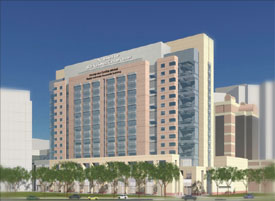The University of Texas M.D. Anderson Cancer Center
Did you know....
 construction has already begun on the cornerstone structure of The Texas Medical Center Research Campus, an integrated research campus fostering collaboration among multiple Texas medical centers including The University of Texas M. D. Anderson Cancer Center, The University of Texas Health Science Center at Houston, and Baylor University?
construction has already begun on the cornerstone structure of The Texas Medical Center Research Campus, an integrated research campus fostering collaboration among multiple Texas medical centers including The University of Texas M. D. Anderson Cancer Center, The University of Texas Health Science Center at Houston, and Baylor University?
Thanks in part to the Permanent University Fund, The University of Texas M. D. Anderson Cancer Center is constructing a major new biomedical research facility, the George and Cynthia Mitchell Basic Sciences Research Building. The $174 million project is being funded by $30 million of PUF bond proceeds, $75 million in private philanthropy, and the remainder from other institutional sources. The building was named after George and Cynthia Mitchell whose generous donation of $20 million was the third largest single donation in UT M. D. Anderson's 60-year history.
Within 505,000 square feet, the George and Cynthia Mitchell Basic Sciences Research Building will contain six floors of modern laboratories. It will also contain a vivarium, or quarters for small animal research, an auditorium, conference facilities, and classroom space for the UT Graduate School of Biomedical Sciences, a shared program of UT M. D. Anderson Cancer Center and UT Health Science Center at Houston.
The innovative and modern design of The University of Texas M. D. Anderson Cancer Center's new biomedical research facility contains movable walls to allow lab spaces to be reconfigured in a matter of hours. This design contains interstitial space, hollow building layers sandwiched between lab floors to house plumbing, air circulation, wiring and flexible areas for any over-sized equipment needed for today's intricate research endeavors. Because of the interstitial space, as future needs dictate, labs can be customized without interrupting neighboring projects. Completion is anticipated in late summer 2003.